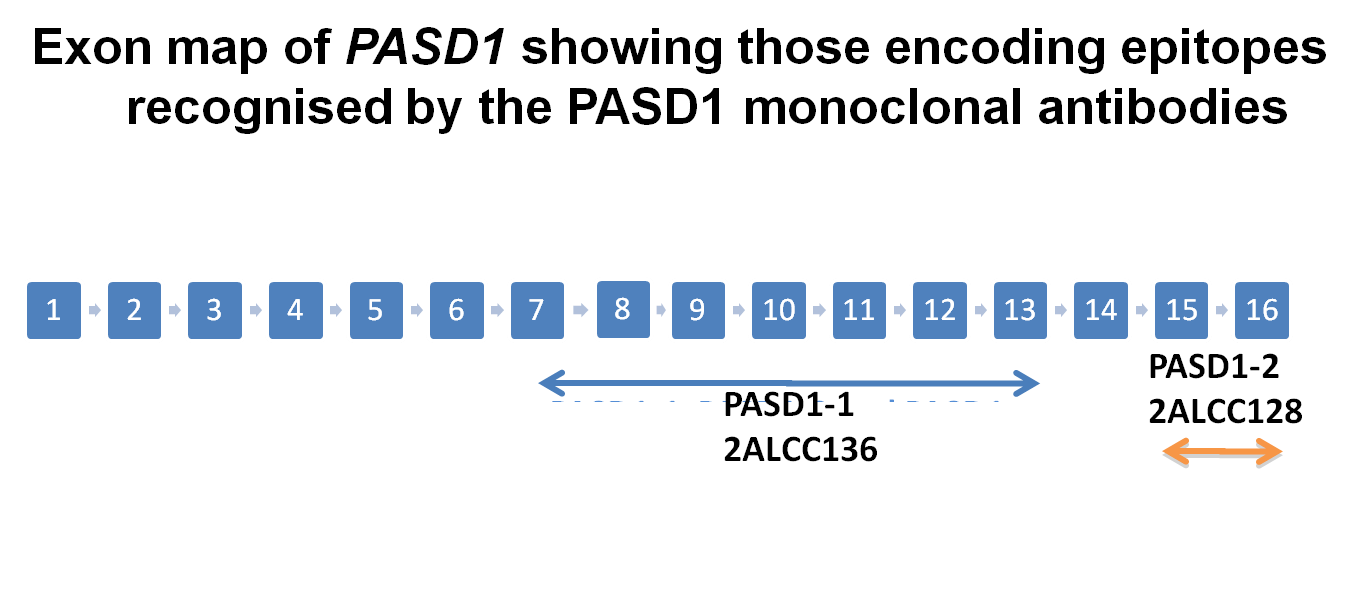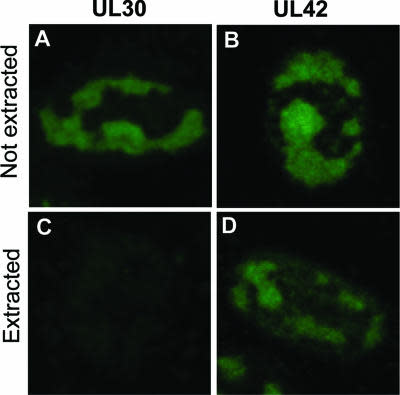Cat. #152546
Anti-PASD1 [2ALCC136]
Cat. #: 152546
Sub-type: Primary antibody
Unit size: 100 ug
Availability: 10-12 weeks
Target: PAS domain-containing protein 1 (PASD1), Per Arnt Sim domain 1
Class: Monoclonal
Application: IHC ; IHC ; IF ; WB
Reactivity: Human
Host: Mouse
£300.00
This fee is applicable only for non-profit organisations. If you are a for-profit organisation or a researcher working on commercially-sponsored academic research, you will need to contact our licensing team for a commercial use license.
Contributor
Inventor: Alison Banham ; Karen Pulford
Institute: University of Oxford
Tool Details
*FOR RESEARCH USE ONLY
- Name: Anti-PASD1 [2ALCC136]
- Clone: 2ALCC136
- Tool sub type: Primary antibody
- Class: Monoclonal
- Conjugation: Unconjugated
- Molecular weight: 100 kDa
- Reactivity: Human
- Host: Mouse
- Application: IHC ; IHC ; IF ; WB
- Description: Cancer testis antigens (CTAs) such as PASD1 represent attractive immunotherapy targets, having normal tissue expression that is testis restricted and commonly widespread expression in tumours. PASD1 was originally identified as a target of anti-tumour immune responses in patients with aggressive diffuse large B-cell lymphoma. Subsequent studies have identified PASD1 expression in myeloma patients (both pre- and post-treatment) and in a broad range of solid tumours, 65/160 samples (41%) from 9 histological types. Interestingly a new immune response to PASD1 was detected in a melanoma patient who exhibited a systemic immune response to palliative radiotherapy with regression of nonirradiated lesions, the abscopal effect. Delivery of immunogenic PASD1 peptides using a DNA vaccine was able to induce immune responses in preclinical models, demonstrating its potential for immunotherapy applications. There is relatively little information regarding the function of many CTAs. However, recently PASD1 has been identified as a novel regulator of the circadian clock that interacts with the CLOCK:BMAL1 complex to repress its transcriptional activation. This suggests that PASD1 may contribute to oncogenic transformation through the suppression of circadian rhythms.
- Immunogen: GST-PASD1 recombinant protein containing 195-474 aas of PASD1. Region is common to PASD1a and PASD1b proteins.
- Isotype: IgG
- Myeloma used: NS0
- Recommended controls: PASD-1 transfected cells and testis; BT-20 and NCI-H1299 carcinoma lines (negative control: MDA-MB-231, tonsil)
Target Details
- Target: PAS domain-containing protein 1 (PASD1), Per Arnt Sim domain 1
- Molecular weight: 100 kDa
- Tissue cell line specificity: PASD-1 transfected cells and testis; BT-20 and NCI-H1299 carcinoma lines (negative control: MDA-MB-231, tonsil)
- Target background: Cancer testis antigens (CTAs) such as PASD1 represent attractive immunotherapy targets, having normal tissue expression that is testis restricted and commonly widespread expression in tumours. PASD1 was originally identified as a target of anti-tumour immune responses in patients with aggressive diffuse large B-cell lymphoma. Subsequent studies have identified PASD1 expression in myeloma patients (both pre- and post-treatment) and in a broad range of solid tumours, 65/160 samples (41%) from 9 histological types. Interestingly a new immune response to PASD1 was detected in a melanoma patient who exhibited a systemic immune response to palliative radiotherapy with regression of nonirradiated lesions, the abscopal effect. Delivery of immunogenic PASD1 peptides using a DNA vaccine was able to induce immune responses in preclinical models, demonstrating its potential for immunotherapy applications. There is relatively little information regarding the function of many CTAs. However, recently PASD1 has been identified as a novel regulator of the circadian clock that interacts with the CLOCK:BMAL1 complex to repress its transcriptional activation. This suggests that PASD1 may contribute to oncogenic transformation through the suppression of circadian rhythms.
Applications
- Application: IHC ; IHC ; IF ; WB
Handling
- Format: Liquid
- Concentration: 0.9-1.1 mg/ml
- Unit size: 100 ug
- Storage buffer: PBS with 0.02% azide
- Storage conditions: -20° C
- Shipping conditions: Shipping at 4° C
Related Tools
- Related tools: Anti-PASD1 [2ALCC128]
References
- Boullosa et al. 2018. Oncotarget. 9(3):3853-3866. PMID: 29423088.
- Identification of survivin as a promising target for the immunotherapy of adult B-cell acute lymphoblastic leukemia.
- Brooks et al. 2015. PLoS One. 10(10):e0140483. PMID: 26492414.
- Application of the pMHC Array to Characterise Tumour Antigen Specific T Cell Populations in Leukaemia Patients at Disease Diagnosis.
- Khan et al. 2015. Biomark Cancer. 7:31-8. PMID: 26327782.
- Infrequent Expression of the Cancer-Testis Antigen, PASD1, in Ovarian Cancer.
- Michael et al. 2015. Mol Cell. 58(5):743-54. PMID: 25936801.
- Cancer/Testis Antigen PASD1 Silences the Circadian Clock.
- Hardwick et al. 2013. Cancer Immun. 13:16. PMID: 23882161.
- An analogue peptide from the Cancer/Testis antigen PASD1 induces CD8+ T cell responses against naturally processed peptide.
- Ait-Tahar et al. 2011. Haematologica. 96(1):78-86. PMID: 20851862.
- Joseph-Pietras et al. 2010. Leukemia. 24(11):1951-9. PMID: 20861911.
- DNA vaccines to target the cancer testis antigen PASD1 in human multiple myeloma.
- CD4-positive T-helper cell responses to the PASD1 protein in patients with diffuse large B-cell lymphoma.
- Ait-Tahar et al. 2009. Br J Haematol. 146(4):396-407. PMID: 19552722.
- Cytolytic T-cell response to the PASD1 cancer testis antigen in patients with diffuse large B-cell lymphoma.
- Cooper et al. 2006. Leukemia. 20(12):2172-4. PMID: 17024112.
- Sahota et al. 2006. Blood. 108(12):3953-5. PMID: 17114574.
- PASD1 is a potential multiple myeloma-associated antigen.
- PASD1, a DLBCL-associated cancer testis antigen and candidate for lymphoma immunotherapy.







